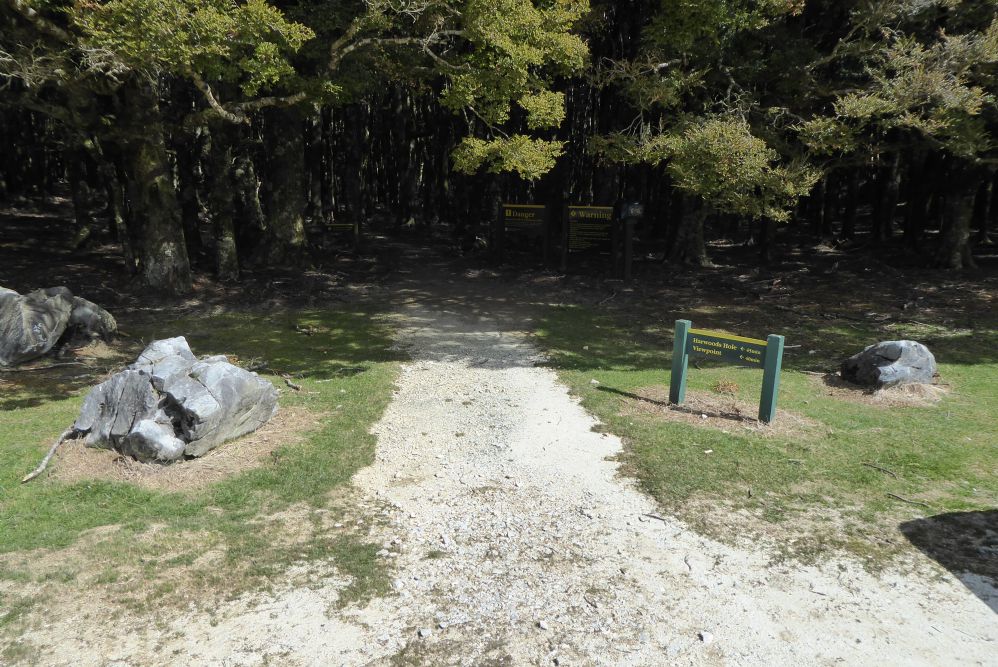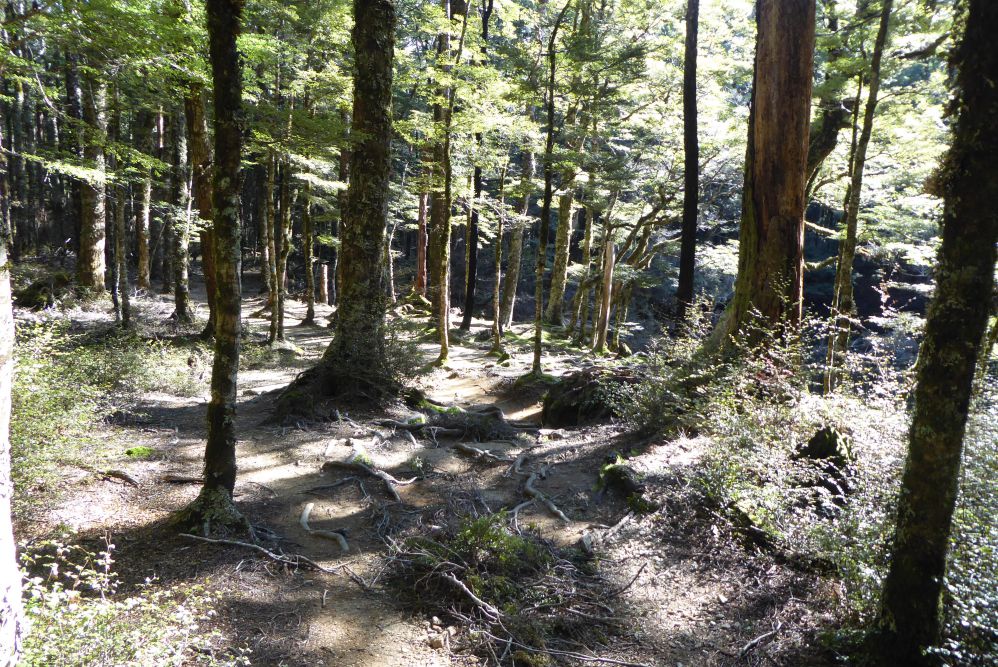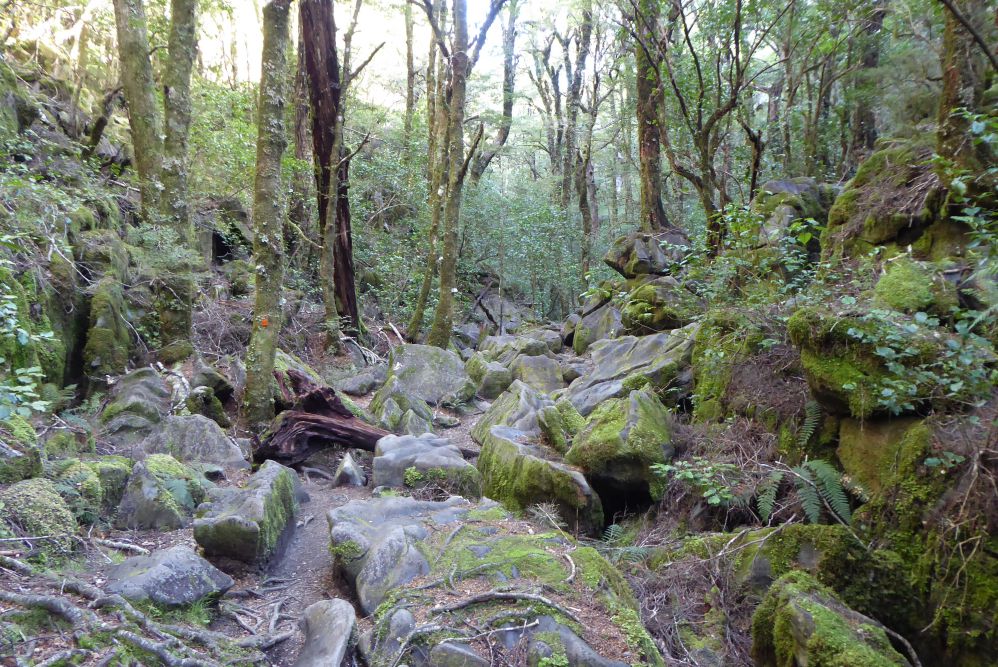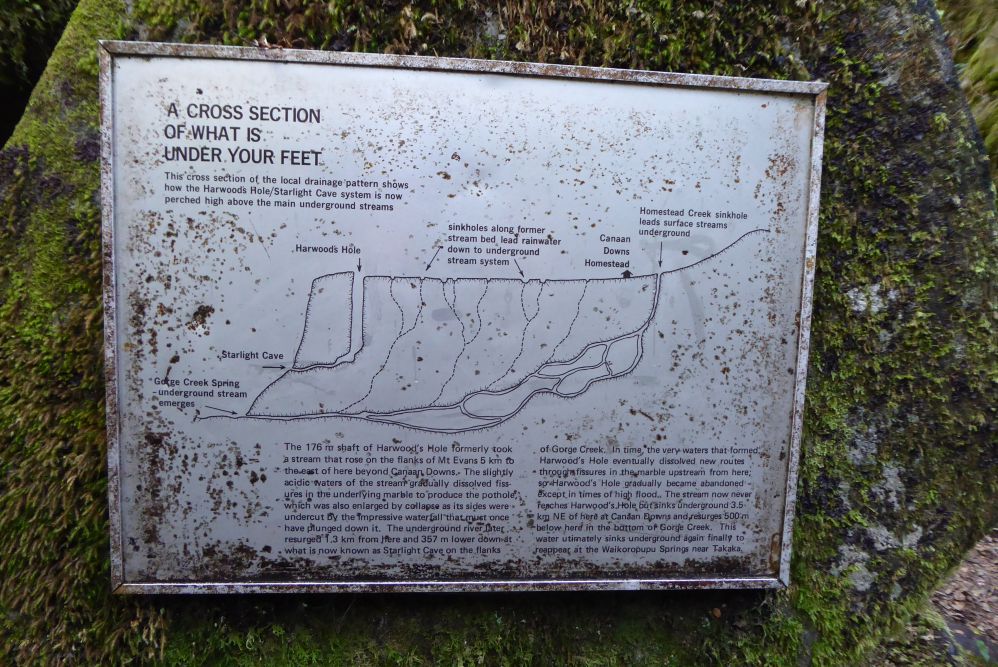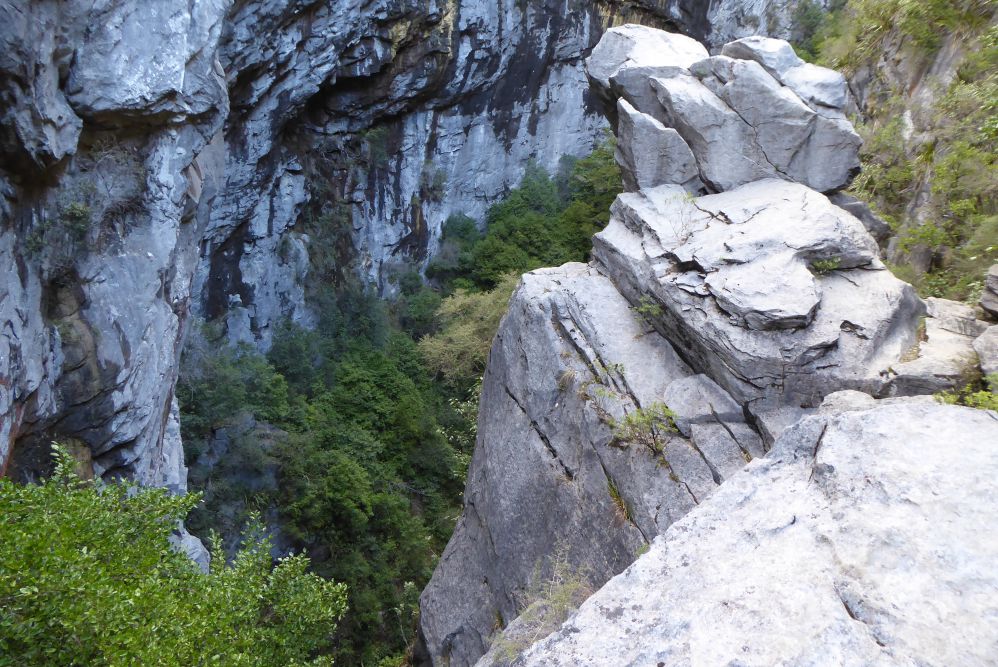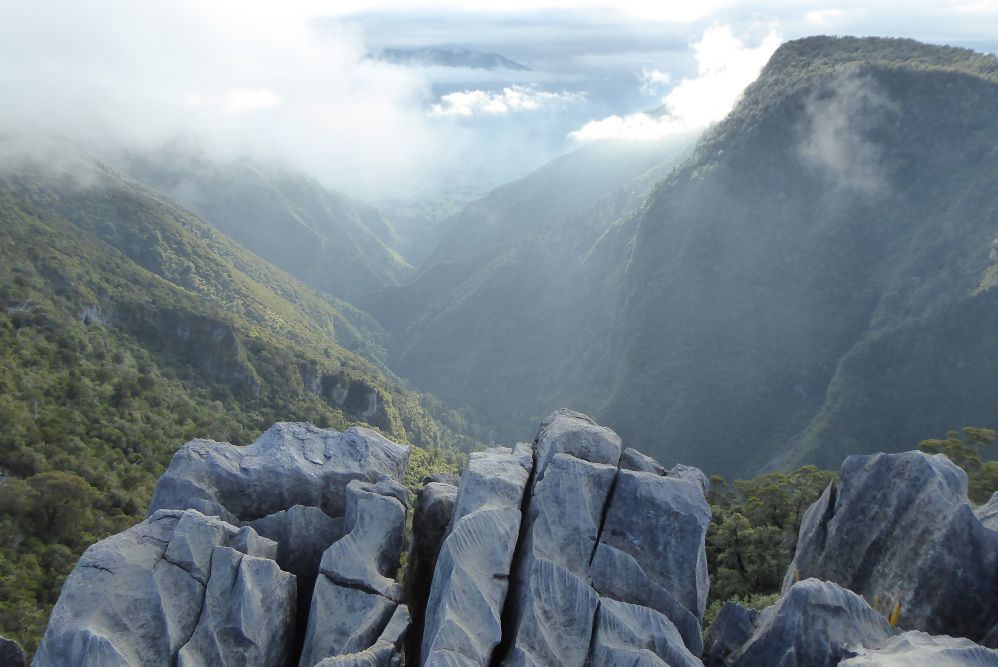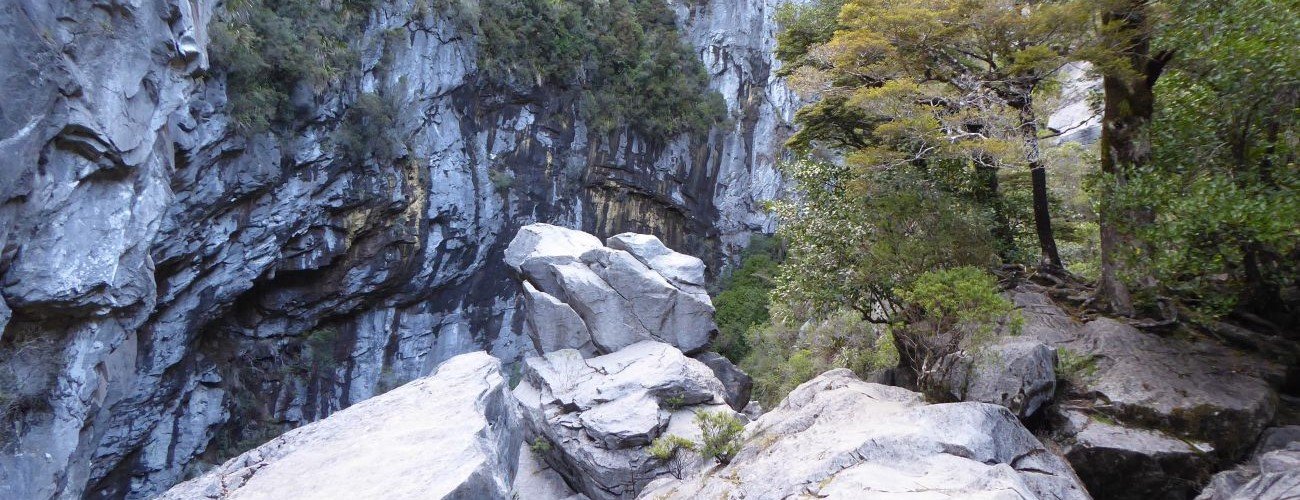
Harwoods Hole is a 357 metre deep sinkhole in Abel Tasman National Park, and is the deepest vertical shaft in New Zealand (176 m). Harwoods Hole Track is a short walk beginning at Canaan Downs car park, passing through beech forest and over interesting marble rock formations. A side track to Gorge Creek Lookout gives impressive views to Takaka Valley. The hole is named after Henry Harwood (1844–1927), whose family has had a long association with Takaka Hill and the Upper Takaka Valley.
| Details | |
| Length | 4.4 km return |
| Time Required | 1 hr 30 min return |
| Trail Type | Walking track |
| Physical Difficulty | Easy |
| Uses | Walking |
| Direction | Return (out and back) |
| Dog Access | Dogs are prohibited in Abel Tasman National Park |
If any layers fail to load, try clearing your cache and refreshing the page.
Aside from Gorge Creek Lookout, Harwoods Hole Track does not connect to any other tracks.
1 hr 30 min from Nelson | 55 min from Takaka
Harwoods Hole track begins at Canaan Downs car park. From Nelson, follow State Highway 60 to the top of Takaka Hill. Turn right onto Canaan Road, which is just past the Ngarua Cave turnoff. Canaan Road is unsealed, windy and narrow, so drive with caution. It is 11 km from the turnoff to Canaan Downs car park. The car park is also the start point for Moa Park Track, Rameka Track, Canaan Downs MTB tracks, and overnight tramps to Wainui Hut.
Harwoods Hole Track is entirely within Abel Tasman National Park and is administered by DOC.
From the car park the track immediately enters beech forest, the trunks of which are sparsely-growing, giving the forest an airy feel. The track descends gently through the forest in a wide, flat gully. There are several karst ponds on the right side of the track along the way. After 1.5 km the gully narrows, and the track clambers over a jumbled mass of moss-covered marble boulders; this is the bed of the stream that was involved in the formation of Harwoods Hole long ago.
After 2.2 km you will reach the massive amphitheater that encircles the entrance to the Harwoods Hole. The track ends here, at a mass of boulders which you can climb over. The opening of the hole is about 50 metres across, but you cannot see down the shaft. Do not attempt to get close to the edge (see safety section below).
Return the way you came.
Gorge Creek Lookout is a short deviation off the main track. The lookout gives impressive views over Gorge Creek valley and Takaka Valley, from a fractured marble outcrop.
There are no barriers around the edge of the hole. You cannot see down the hole, so do not attempt to get close to the edge. Do not throw objects down the hole as there may be caving parties below. Be careful climbing over the large boulders as some are sharp and some are slippery.
Harwoods Hole is part of the renowned Takaka Hill-Canaan Downs karst complex. The first descent was made in 1958, and a year later the bottom of the shaft was linked to Starlight Cave, 1.3 km away, in Gorge Creek. From the shaft entrance to the Starlight Cave exit, the overall depth of the system is 357 m, which for a time made it the deepest known cave system in New Zealand.
Cave and sinkhole formation occur through chemical action between water and rock. Water can become slightly acidic through absorption of carbon dioxide, primarily from soil, to the point where it becomes a week carbonic acid. Limestone, and its metamorphosed form marble, are alkaline, meaning they are dissolvable by acid. Over time, acidic water flows to natural points of weakness in the rock, like cracks, cleavages and fissures. Over time, these weaknesses are magnified and become preferential drainage pathways, leading to the formation of a cave system. While at first the process is chemical, it soon becomes mechanical, as the flowing water erodes and smooths surfaces, and debris scours out channel beds. Geochemists have estimated that up to 100 m3 of marble can be dissolved from a single square kilometre of Takaka Hill per year. Given its size, Harwoods Hole would have taken tens of thousands of years to form.
In ancient times, a stream drained the western side of Mt Evans and flowed down the bed that the track now follows. This stream gradually formed Harwoods Hole, and at one point it is suggested that a large, impressive waterfall poured into the hole as it grew deeper. Over time, development of other sinkholes further upstream in the catchment drew water underground before it reached Harwoods Hole, eventually disconnecting it from the hydrologic system that created it. Today the catchment drains underground at Homestead Creek sinkhole, 3.5 km north of Harwoods Hole. A subterranean water system takes the water much deeper than the basement of Harwoods Hole, to a resurgence into Gorge Creek, 150 m vertical metres lower than Starlight Cave. Harwoods Hole still conveys a localised water system, and so long as water is flowing, the cave formation process remains in action.
Harwoods Hole is a 357 metre deep sinkhole in Abel Tasman National Park, and is the deepest vertical shaft in New Zealand (176 m). Harwoods Hole Track is a short walk beginning at Canaan Downs car park, passing through beech forest and over interesting marble rock formations. A side track to Gorge Creek Lookout gives impressive views to Takaka Valley. The hole is named after Henry Harwood (1844–1927), whose family has had a long association with Takaka Hill and the Upper Takaka Valley.
| Details | |
| Length | 4.4 km return |
| Time Required | 1 hr 30 min return |
| Trail Type | Walking track |
| Physical Difficulty | Easy |
| Uses | Walking |
| Direction | Return (out and back) |
| Dog Access | Dogs are prohibited in Abel Tasman National Park |
1 hr 30 min from Nelson | 55 min from Takaka
Harwoods Hole track begins at Canaan Downs car park. From Nelson, follow State Highway 60 to the top of Takaka Hill. Turn right onto Canaan Road, which is just past the Ngarua Cave turnoff. Canaan Road is unsealed, windy and narrow, so drive with caution. It is 11 km from the turnoff to Canaan Downs car park. The car park is also the start point for Moa Park Track, Rameka Track, Canaan Downs MTB tracks, and overnight tramps to Wainui Hut.
Harwoods Hole Track is entirely within Abel Tasman National Park.
From the car park the track immediately enters forest comprised of silver beech, the trunks of which are sparsely-growing, giving the forest an airy feel. The track descends gently through the forest in a wide, flat gully. There are several karst ponds on the right side of the track along the way. After 1.5 km the gully narrows, and the track clambers over a jumbled mass of moss-covered marble boulders; this is the bed of the stream that was involved in the formation of Harwoods Hole long ago.
After 2.2 km you will reach the massive amphitheater that encircles the entrance to the Harwoods Hole. The track ends here, at a mass of boulders which you can climb over. The opening of the hole is about 50 metres across, but you cannot see down the shaft. Do not attempt to get close to the edge (see safety section below).
Return the way you came.
Gorge Creek Lookout is a short deviation off the main track. The lookout gives impressive views over Gorge Creek valley and Takaka Valley, from a fractured marble outcrop.
There are no barriers around the edge of the hole. You cannot see down the hole, so do not attempt to get close to the edge. Do not throw objects down the hole as there may be caving parties below. Be careful climbing over the large boulders as some are sharp and some are slippery.
Harwoods Hole is part of the renowned Takaka Hill-Canaan Downs karst complex. The first descent was made in 1958, and a year later the bottom of the shaft was linked to Starlight Cave, 1.3 km away, in Gorge Creek. From the shaft entrance to the Starlight Cave exit, the overall depth of the system is 357 m, which for a time made it the deepest known cave system in New Zealand.
Cave and sinkhole formation occur through chemical action between water and rock. Water can become slightly acidic through absorption of carbon dioxide, primarily from soil, to the point where it becomes a week carbonic acid. Limestone, and its metamorphosed form marble, are alkaline, meaning they are dissolvable by acid. Over time, acidic water flows to natural points of weakness in the rock, like cracks, cleavages and fissures. Over time, these weaknesses are magnified and become preferential drainage pathways, leading to the formation of a cave system. While at first the process is chemical, it soon becomes mechanical, as the flowing water erodes and smooths surfaces, and debris scours out channel beds. Geochemists have estimated that up to 100 m3 of marble can be dissolved from a single square kilometre of Takaka Hill per year. Given its size, Harwoods Hole would have taken tens of thousands of years to form.
In ancient times, a stream drained the western side of Mt Evans and flowed down the bed that the track now follows. This stream gradually formed Harwoods Hole, and at one point it is suggested that a large, impressive waterfall poured into the hole as it grew deeper. Over time, development of other sinkholes further upstream in the catchment drew water underground before it reached Harwoods Hole, eventually disconnecting it from the hydrologic system that created it. Today the catchment drains underground at Homestead Creek sinkhole, 3.5 km north of Harwoods Hole. A subterranean water system takes the water much deeper than the basement of Harwoods Hole, to a resurgence into Gorge Creek, 150 m vertical metres lower than Starlight Cave. Harwoods Hole still conveys a localised water system, and so long as water is flowing, the cave formation process remains in action.
Aside from Gorge Creek Lookout, Harwoods Hole Track does not connect to any other tracks.
Updated 7 February 2019
